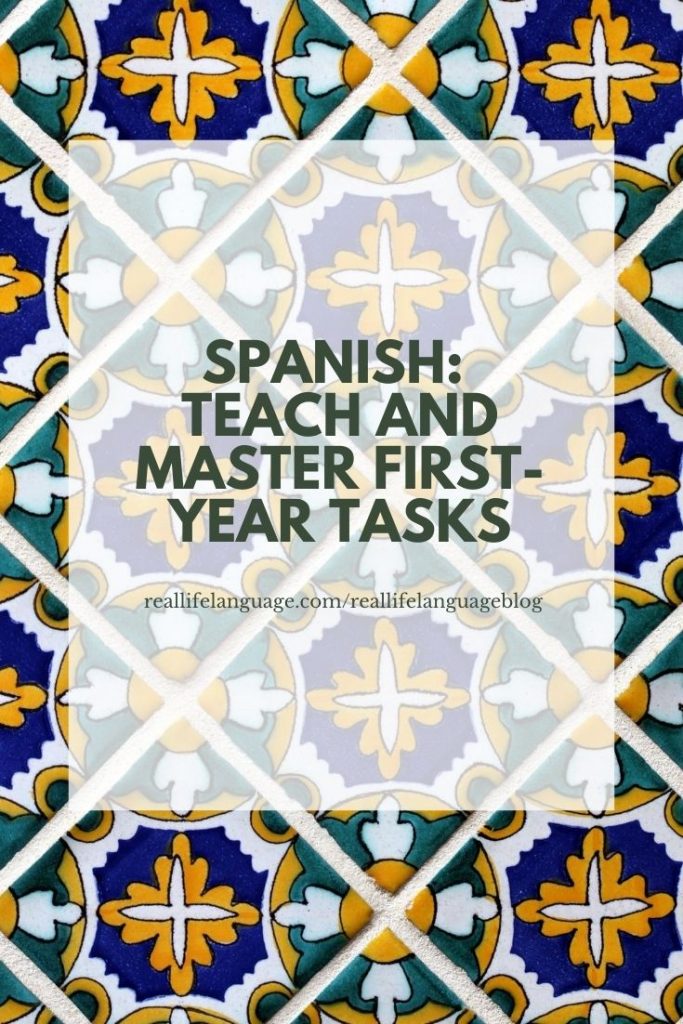
Spanish: Teach and Master
First-year Tasks
I like to focus on this list of tasks in first-year Spanish. It helps me plan what to teach and assess.
We teach students to do a lot in our classes. Try this fun activity to review and master the major communicative tasks.
At the end of the first year of Spanish, I love to do this activity. We have all of the tasks written on pieces of paper and they are distributed to students. Let them work in groups to brainstorm and review.
While they are reviewing, you will cut those tasks into little slips of paper. Teams will take turns drawing tasks from a bag or hat. Assign each task (or part) a point value.
After everyone has had to time to review how to do these tasks, start the game. Everyone puts away their notes.
I like to be flexible with our rules. You may want to allow a certain number of lifelines, or let pairs from a group answer together. The point is to learn while having fun, so adapt this to your group as you will know best.
Spanish: Teach and Master These Tasks
Name the countries in the Spanish-speaking world.
Name the capitals of Spanish-speaking countries.
Greet people in the morning.
Greet someone in the afternoon.
Greet someone in the evening.
Ask someone what their name is.
Say what your name is.
Say the word for you formal.
Say the word for you informal.
Ask someone how they are (formal).
Ask someone how they are (informal).
Say how you are.
Take leave.
Tell someone that they are pleased to meet them.
Have a conversation in which you meet someone for the first time.
Say basic classroom commands.
Count to ten in Spanish.
Count to twenty in Spanish.
Say your phone number in Spanish.
Say at least five body parts in Spanish.
Say the names for at least five things you use at school. Use the correct article.
Ask how something is said in Spanish.
Say the alphabet in Spanish.
Spell your name in Spanish.
Spell the names of your family members in Spanish.
Say the days of the week.
Say the months of the year.
Ask what day it is.
Ask what the date is.
Say today and tomorrow.
Ask what the weather is like.
Say what the weather is like.
Say the seasons.
Say the verbs for basic activities in the infinitive form.
Say what you like to ask.
Ask someone what they like to do.
Say who you are.
Say what you don’t like.
Agree with what you like.
Agree with what you don’t like.
Describe your personality. Use adjectives that agree with their noun.
Say the four ways to say the in Spanish.
Say the names of your classes.
Describe your classes.
Say I.
Say you formal.
Say you informal.
Say you formal (plural).
Say you informal (plural).
Using the yo form, say things you do on a regular basis.
Say the names for at least ten items in your classroom. Use the correct article.
Use basic prepositions to describe where things are located.
Use the verb estar to talk about where things are located.
Use the verb estar to talk about where people are located.
Say a and an in Spanish.
Say what your possessions are.
Ask what.
Ask who and/or which.
Ask when.
Ask what something is.
Ask what there is or there are.
Ask how many.
Ask where is..
Ask from where…
Ask why..
Say what you love.
Say basic foods.
Say the names of meals.
Say the name s of basic drinks.
Say what other people do using the present tense.
Say basic physical exercises.
Express hunger.
Express thirst.
Express being tired.
Say the time.
Express what you eat in the morning.
Express what you eat in the afternoon.
Express what you eat in the evening.
Express your opinions on food.
State the things that you have.
State the things that other people have.
Say the names of common places in your community.
Say what you do in your free time.
Say where you go in your free time.
Say what you do on different days of the week.
Say where different people go.
Say when activities are done.
Say at what time different activities are done.
Say the names of sports.
Say what sports you play.
Say what sports others play.
Extend invitations.
Politely decline invitations.
Express to someone that you are sorry.
State the things that you have to do.
State the things that others have to do.
Say what you are going to do in the future.
Describe how you are feeling.
As this is the start of the year, consider posting these in your classroom as lessons to teach to meet these proficiency targets throughout the year.
Are you looking for more ready-to-go Spanish lessons that teach these tasks? Immersive Spanish Lessons
Looking for some more ideas for your language class? There are loads of ideas to teach Spanish at all levels. World Language Class: 5 Weeks of Low and No Prep Fun-Week 3
[leadpages_leadbox leadbox_id=1442175c6639c5] [/leadpages_leadbox]
I like the concise nature of your list. These can be great for quick turn and talk.